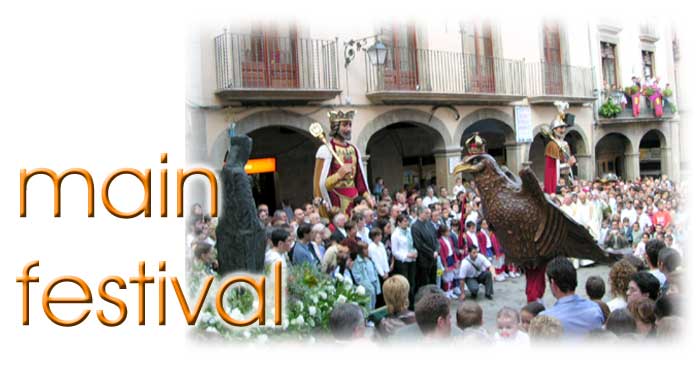
 |
||||||
|
|
|
|
|
|
|
|
|
|
||||||
|
The Location / Around the celebration / The Town hall / The Music Solsona's main festival is one of the oldest as well as one of the most traditional celebrations that are currently celebrated around the country. This rich and secular heritage goes back in the past down to the 14th century. The location These locations have remained untouched since medieval times and for this reason an effort has been made so that they do not come out of the walled town or old quarter. It is important for the symbolism that for three centuries the giants and the other figures have danced in the same places and have never been out of the walls of the city. Our celebration shows two visible features that are crucial, the Mediterranean character and the festive space. The first feature is seen in the dances taking place in the centre of the town and the most important moment is the twelve dances on the main square. This square has a especial symbolism because it is the place where the two population groups merged and became one town. Solsona's main festival is one of the most ancient in Catalonia. The town was worshiping the Virgin of the Cloister on the 8th of September in the 14th century already. The oldest documented outline of the celebration dates back to 1675 and it is a copy of the current one. This is why it is important to reinforce the traditional events of the main festival because in Catalonia there are only two places where this ancient and organized outline has been maintained; Solsona and Olot. We must mention that Solsona was also one of the first towns to celebrate the Corpus Christi. Pope John XVII in the year 1318 extended the celebration to the church and that is why there is a long tradition in the local folklore. Barcelona is the second city in the world to celebrate it in 1320. Solsona in 1331, together with Bagā among others, and the rest of the towns began much later. From the beginning of the celebration, the going down to the cathedral and back up to the town hall was established in a spontaneous way. However, we know that the most important event, the dances began in 1431 on the church square. These elements were integrated in the main festival and are important because they have survived without much variation for nearly 600 years. | ||||||||||||||||||||||||||||||||
|
Around
the celebration | ||||||||||||||||||||||||||||||||
|
The Town hall
This
association was founded around the year 1475 and they were in charge
of administrating the virgin's chapel and the different celebrations
that took place. Later on, they also administered the properties
or money that was offered to the virgin of the Cloister. In 1653
it was newly reformed. La Vint-i-quatrena - This institution as it is at present, was created in 1689. At the beginning it was a post for life and with the last reform it became stronger with new ideas. Their members meet to control the virgin's assets and administer its property. They go behind the bishop during the procession. La Cofraria - They are the largest group and the members are catholic people from Solsona's parish in charge of electing the Vint-i-quatrena . El Pendonista - Every year a new pendonista is elected and his role is to carry the Catalan flag at the front of the procession, followed by the virgin. El Laus Prennis - This institution is exclusively formed by women and they have their celebration the Sunday after Solsona's main festival. They are in charge of tending to the virgin every Saturday during the Sabatina. L'escolania - choir that sings during the masses celebrated at the virgin's chapel throughout the year. The giants carriers In
the past, the people making the giants dance were compensated economically,
but in 1973 people began to get very interested in promoting popular
Catalan traditions and in the 70īs a group of young people
began to take over from the old people doing this task. There
was a new generation with the challenge of recuperating the old
traditions. El
macip major - As a representative of the giant carriers the
macip major is in charge of presiding and organizing the different
groups. | ||||||||||||||||||||||||||||||||
|
Music plays a very important role in the celebration and Solsona has appropriate music for each different moment of the festival. We have the pasdobles used for the giants or other figures to go to the place where they will begin the dance, and the music for every dance always played on the main square. The
Pasdobles music Since 1977 the orchestra Patinfanjās made up with people from Solsona has been the main one, in charge of playing in the processions from the town hall to the cathedral and the return journey. People associate a certain moment of the celebrations with the corresponding music. In the past the giants would go around the streets with the same music all the time. It was called "Bajo la doble āliga", and part of it is still used nowadays. The rest of the music is from the middle of the 20th century to the present day. One of the best musicians of the 20th century is Joan Roure i Jané and his music is combined with other popular music. This local musician had a very important role because apart from composing, he also improved some of the music for a better sound.
|
Main
Festival /
The history /
Figures
of the Main Festival /E-mail
/ Home